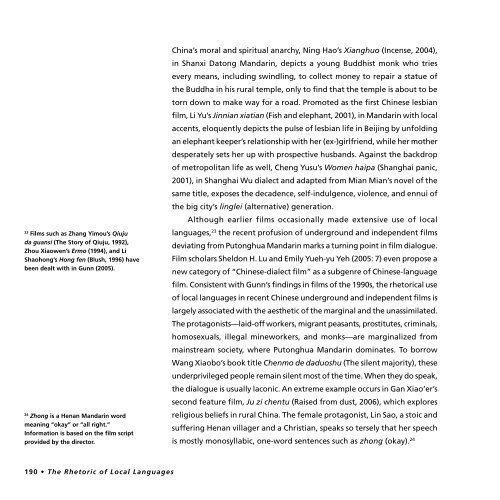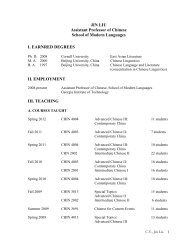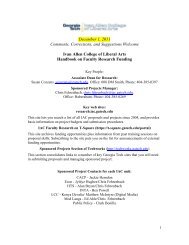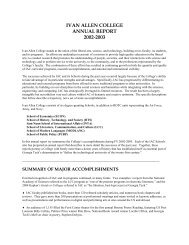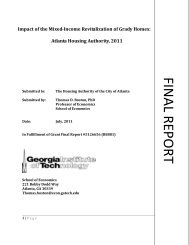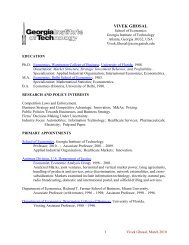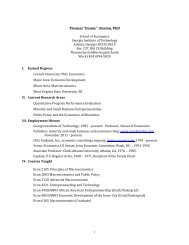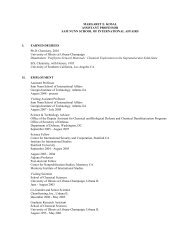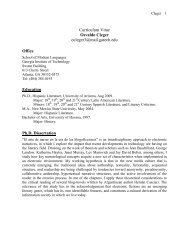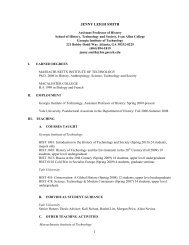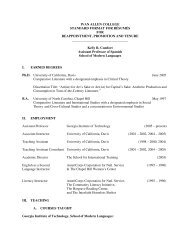Read this paper
Read this paper
Read this paper
Create successful ePaper yourself
Turn your PDF publications into a flip-book with our unique Google optimized e-Paper software.
China’s moral and spiritual anarchy, Ning Hao’s Xianghuo (Incense, 2004),<br />
in Shanxi Datong Mandarin, depicts a young Buddhist monk who tries<br />
every means, including swindling, to collect money to repair a statue of<br />
the Buddha in his rural temple, only to find that the temple is about to be<br />
torn down to make way for a road. Promoted as the first Chinese lesbian<br />
film, Li Yu’s Jinnian xiatian (Fish and elephant, 2001), in Mandarin with local<br />
accents, eloquently depicts the pulse of lesbian life in Beijing by unfolding<br />
an elephant keeper’s relationship with her (ex-)girlfriend, while her mother<br />
desperately sets her up with prospective husbands. Against the backdrop<br />
of metropolitan life as well, Cheng Yusu’s Women haipa (Shanghai panic,<br />
2001), in Shanghai Wu dialect and adapted from Mian Mian’s novel of the<br />
same title, exposes the decadence, self-indulgence, violence, and ennui of<br />
the big city’s linglei (alternative) generation.<br />
Although earlier films occasionally made extensive use of local<br />
23<br />
Films such as Zhang Yimou’s Qiuju<br />
da guansi (The Story of Qiuju, 1992),<br />
Zhou Xiaowen’s Ermo (1994), and Li<br />
Shaohong’s Hong fen (Blush, 1996) have<br />
been dealt with in Gunn (2005).<br />
languages, 23 the recent profusion of underground and independent films<br />
deviating from Putonghua Mandarin marks a turning point in film dialogue.<br />
Film scholars Sheldon H. Lu and Emily Yueh-yu Yeh (2005: 7) even propose a<br />
new category of “Chinese-dialect film” as a subgenre of Chinese-language<br />
film. Consistent with Gunn’s findings in films of the 1990s, the rhetorical use<br />
of local languages in recent Chinese underground and independent films is<br />
largely associated with the aesthetic of the marginal and the unassimilated.<br />
The protagonists—laid-off workers, migrant peasants, prostitutes, criminals,<br />
homosexuals, illegal mineworkers, and monks—are marginalized from<br />
mainstream society, where Putonghua Mandarin dominates. To borrow<br />
Wang Xiaobo’s book title Chenmo de daduoshu (The silent majority), these<br />
underprivileged people remain silent most of the time. When they do speak,<br />
the dialogue is usually laconic. An extreme example occurs in Gan Xiao’er’s<br />
second feature film, Ju zi chentu (Raised from dust, 2006), which explores<br />
24<br />
Zhong is a Henan Mandarin word<br />
meaning “okay” or “all right.”<br />
Information is based on the film script<br />
provided by the director.<br />
religious beliefs in rural China. The female protagonist, Lin Sao, a stoic and<br />
suffering Henan villager and a Christian, speaks so tersely that her speech<br />
is mostly monosyllabic, one-word sentences such as zhong (okay). 24<br />
190 • The Rhetoric of Local Languages<br />
MCLC 18.2.indd 190<br />
12/20/06 2:01:39 PM


